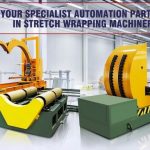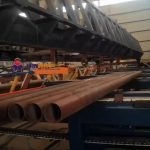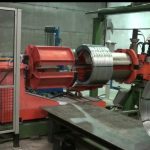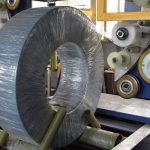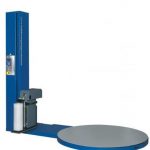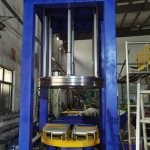How Steel Coil Packing Lines Work: A Step-by-Step Guide
- How Steel Coil Packing Lines Work: A Step-by-Step Guide
- 1. Introduction to Steel Coil Packing Lines
- 2. Key Components of a Steel Coil Packing Line
- 3. How Automation Transforms the Packaging Process
- 4. Step-by-Step Overview of the Packing Process
- 5. Coil Strapping Station: Ensuring Load Security
- 6. Automated Stacking and Storage Solutions
- 7. Pallet Strapping and Outfeeding Process
- 8. Quality Control in Steel Coil Packaging Lines
- 9. Safety Measures in Steel Coil Packaging Lines
- 10. Regular Maintenance for Optimal Performance

Steel coil packing lines are critical to the manufacturing and logistics process, ensuring that coils are securely packaged for shipping, handling, and storage. The precision and speed provided by modern packing lines not only save time and labor costs but also protect the valuable steel coils from damage.
In this comprehensive guide, we will explore how steel coil packing lines work, outlining each step in the process and highlighting the key components involved. Whether you are a business owner considering an investment or a logistics professional aiming to streamline operations, this guide offers the insights you need.
1. Introduction to Steel Coil Packing Lines
Steel coils are used across various industries, including construction, automotive, and manufacturing, where their handling and protection are of utmost importance. Given the heavy weight and large size of steel coils, efficient packing is necessary to maintain product integrity and avoid damages during transit.
a. Manual vs. Automated Coil Packaging
In the past, coil packing relied heavily on manual labor, which led to issues such as inconsistent packaging quality, damage risks, and high labor costs. However, advancements in automation have transformed the process, enabling businesses to pack more efficiently and reliably while reducing errors.
Automation significantly reduces the manual handling involved in the packing process, allowing for higher throughput and ensuring consistent, damage-free packaging. This, in turn, helps businesses improve their bottom line and meet customer demands more effectively.
2. Key Components of a Steel Coil Packing Line
A steel coil packing line consists of multiple interconnected components, each designed to handle different aspects of the process. These systems work together to ensure the coils are packaged securely and transported efficiently.
a. Turnstile
The turnstile plays a vital role in loading and holding the coils in position. It rotates and presents the coils one at a time to the packaging line, allowing for a continuous flow of coils without the need for frequent intervention by operators. This helps reduce downtime and speeds up the packaging process.
b. Coil Down-Ender
The coil down-ender is a crucial piece of equipment that rotates the coil from a horizontal (eye to wall) position to a vertical (eye to sky) position. This change in orientation is essential for ensuring proper alignment during the wrapping process. The down-ender typically operates using hydraulic power, enabling it to handle coils weighing up to several tons.
c. Coil Wrapping Machine
The coil wrapping machine is one of the core components of the steel coil packing line. This machine applies a protective layer, such as stretch film or woven fabric, to the coil. The wrapping protects the coil from moisture, dust, and mechanical damage during handling and storage. Many wrapping machines are equipped with adjustable tension settings, allowing operators to customize the wrapping based on the material type and the specific requirements of each coil.
3. How Automation Transforms the Packaging Process
Automation plays a central role in modern steel coil packing lines. By integrating advanced technologies like PLC systems and automated conveyors, companies can reduce the reliance on manual labor, minimize errors, and significantly increase throughput.
a. Programmable Logic Controllers (PLC)
A PLC system is at the heart of every automated packing line. It controls the operation of the entire system, from the rotation of the turnstile to the tension of the wrapping machine. The PLC allows for precise control over the packaging process, ensuring that each coil is packed to exact specifications.
b. Conveyor Systems for Efficient Movement
Conveyor systems are used to transport the steel coils from one station to the next. This eliminates the need for forklifts or manual handling, speeding up the process and reducing the risk of damage to the coils. Conveyor systems are typically equipped with buffering zones to ensure a smooth and continuous flow of products through the line.
4. Step-by-Step Overview of the Packing Process
To understand how a steel coil packing line works, let’s take a closer look at each step in the process:
a. Step 1: Loading the Coils onto the Turnstile
The packaging process begins with the loading of steel coils onto the turnstile. This multi-arm turnstile can hold several coils at once, enabling the operator to load multiple coils in advance. The turnstile rotates to present each coil one at a time to the next stage of the process, minimizing downtime.
b. Step 2: Positioning the Coil with the Down-Ender
Next, the coil is picked up by the down-ender, which rotates it from a horizontal position to a vertical position. This step ensures that the coil is properly aligned for wrapping. The down-ender uses hydraulic power to handle even the heaviest coils, ensuring that the process is smooth and efficient.
c. Step 3: Wrapping the Coil
Once the coil is in position, the wrapping machine begins its work. The machine wraps the coil in protective layers of paper, stretch film, or woven fabric, depending on the customer’s specifications. The wrapping material is applied with precise tension, ensuring that the coil is fully protected without damaging its surface.
d. Step 4: Strapping the Coil for Security
After wrapping, the coil is moved to the strapping station, where it is secured with steel straps. Strapping is a crucial step in the process, as it ensures that the coil remains tightly wound during transport, reducing the risk of the coil unraveling or shifting.
5. Coil Strapping Station: Ensuring Load Security
The strapping station is responsible for securing the wrapped coil with strong steel straps. These straps prevent the coil from loosening during handling and transport. Modern strapping stations are equipped with automatic strapping tools, which apply the straps with precise tension to ensure maximum security.
a. Automatic Strapping Tools
Automated strapping tools are powered by pneumatic motors that provide the necessary tension for securing the steel straps. These tools are designed to withstand the harsh environments of industrial settings, making them highly reliable and efficient. The use of automated strapping also reduces the chance of human error, ensuring that each coil is strapped correctly and securely.
b. Strapping Materials and Their Importance
The strapping material used in the process is typically steel, as it provides the strength needed to handle heavy coils. Steel straps are known for their durability and are designed to withstand the pressures of shipping and handling. The strength of the straps ensures that the coil remains intact throughout its journey.

6. Automated Stacking and Storage Solutions
Once the steel coil has been wrapped and strapped, it moves to the final stages of the packaging line, where it is prepared for storage or shipment. This stage emphasizes precision, safety, and efficiency through the use of automated stacking systems.
a. Coil Stacking Machine
The coil stacking machine is responsible for lifting and arranging the packed coils onto pallets. Equipped with vacuum lifters or magnetic handlers, this machine minimizes manual handling, significantly reducing the risk of worker injuries while improving stacking precision. The stacked coils are aligned neatly to ensure maximum stability, making them ready for easy transportation or storage.
b. Pallet Feeding Conveyor
After the coils are stacked, the pallet feeding conveyor ensures the safe and efficient movement of the pallets to the next station. This conveyor system eliminates the need for forklifts or manual handling, streamlining the process and reducing the risk of coil damage.
7. Pallet Strapping and Outfeeding Process
Following the stacking process, the pallet, with coils securely placed, proceeds to the pallet strapping station. This step is critical to ensure that the stacked coils remain intact and stable during transport.
a. Pallet Strapping Machine
The pallet strapping machine wraps steel straps around the entire stack of coils, further securing them onto the pallet. This process ensures that the coils will not shift during shipping, providing extra stability during handling. Some systems use semi-automatic strapping machines, where the operator manually places the straps, while others utilize fully automatic machines that perform the strapping without manual intervention, boosting productivity and consistency.
b. Outfeeding Conveyor
Once the pallet is fully strapped, it is moved by the outfeeding conveyor to the loading area, where it awaits transport. This conveyor system ensures smooth, continuous movement, reducing bottlenecks and ensuring that pallets are ready for dispatch without unnecessary delays.
8. Quality Control in Steel Coil Packaging Lines
Quality control is a critical aspect of steel coil packaging, ensuring that each coil is securely packed and protected from damage during transit. Automated systems often include advanced inspection technologies to maintain consistent packaging quality.
a. Automated Inspection Systems
Modern coil packing lines often feature automated inspection systems that continuously monitor key stages of the packaging process. These systems use sensors and cameras to check for issues such as improper alignment, insufficient wrapping tension, or weak strapping. If an error is detected, the system will either notify operators or automatically correct the problem.
b. Data Logging and Reporting
In addition to real-time monitoring, many packing lines use data logging systems to track the performance of the packaging process. This data can include coil dimensions, tension settings, and strapping strength, allowing operators to generate reports and identify areas for improvement. Businesses can use this data to optimize future operations and ensure consistent quality.
9. Safety Measures in Steel Coil Packaging Lines
Steel coil packaging lines handle extremely heavy and large products, which makes safety a top priority. Modern systems incorporate numerous safety measures to protect workers and equipment during the packing process.
a. Safety Fences and Light Curtains
Most automated coil packing lines are equipped with safety fences that surround the working area, preventing unauthorized access to dangerous machinery. In some cases, light curtains are used to create virtual barriers. If an object or person passes through the light curtain, the machine will automatically stop to prevent accidents.
b. Emergency Stop Systems
Each section of the packing line is fitted with emergency stop buttons. In the event of a malfunction or hazardous situation, operators can quickly stop the machine by pressing these buttons. This ensures that workers can intervene if they detect any problems, minimizing the risk of accidents.
c. Lockout/Tagout (LOTO) Procedures
When maintenance or repairs are needed, Lockout/Tagout (LOTO) procedures ensure that all energy sources are disconnected and cannot be accidentally turned on. This is a crucial safety measure that prevents workers from being injured by moving machinery during maintenance.
10. Regular Maintenance for Optimal Performance
To maintain high performance and efficiency, regular maintenance of steel coil packing lines is essential. Well-maintained equipment not only performs better but also lasts longer, reducing the total cost of ownership.
a. Daily Inspections
Operators should perform daily inspections to check for wear and tear on key components like conveyors, sensors, and hydraulic systems. These checks ensure that the equipment is in good working order and helps identify any potential issues before they lead to breakdowns.
b. Scheduled Maintenance
In addition to daily checks, scheduled maintenance should be performed at regular intervals. This involves more in-depth inspections, such as recalibrating sensors, lubricating moving parts, and replacing worn-out components. By scheduling maintenance ahead of time, businesses can avoid unexpected downtime and keep the packing line running efficiently.
c. Spare Parts Inventory
Keeping a well-stocked inventory of spare parts is crucial for minimizing downtime during repairs. Essential parts, such as belts, sensors, and strapping tools, should always be on hand to ensure that repairs can be completed quickly and efficiently. Many equipment manufacturers provide recommended spare parts lists, making it easier to keep the necessary components in stock.
